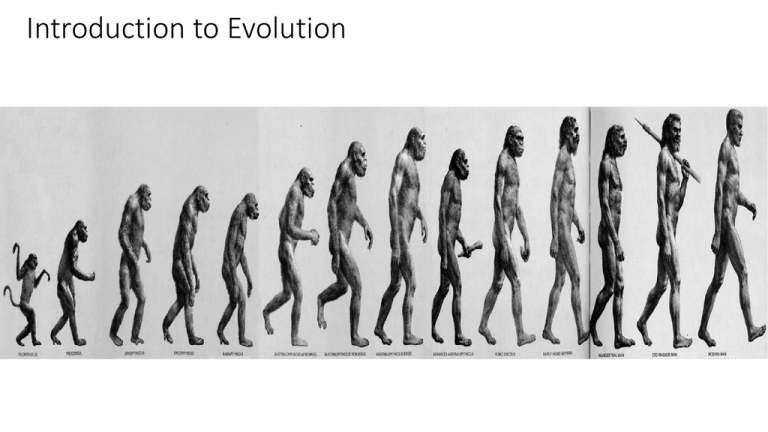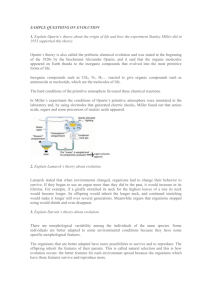Introduction to Evolution
advertisement

Introduction to Evolution Introduction to Evolution A controversial subject- why? • Religious Beliefs • Theory vs. fact– a theory is an idea that has some evidence to support it, but is not accepted as fact • Evolution means change in living things • Changes in gene frequencies that are heritable- actually not as controversial • What is controversial? • Beginning of life and where man came from Big Question: Where life came from? • To answer this scientifically you must answer • Where organic compounds come from • How those molecules are chained into polymers • How self replicating molecules could be originate (so genetic info can be passed) • How all these molecules can be packaged into membranes that have a different chemistry than their surroundings Aleksandr Oparin • Oparin (Russian) and Haldane (British) in the 1920’s suggested that organic compounds could have been formed in the Earth’s ancient oceans (really a hypothesis- no proof) Aleksandr Oparin • "Primordial soup" is a term introduced by the Soviet biologist Alexander Oparin. • In 1924, he proposed a theory of the origin of life on Earth through the transformation, during the gradual chemical evolution of molecules that contain carbon in the primordial soup. • By further transformation, more complex organic polymers – and ultimately life – developed in the soup. Stanley Miller • Stanley Miller created an experiment that made amino acids from methane, ammonia, water, hydrogen atmosphere • Miller’s experiment was brilliant and it produced 13 of 20 amino acids. He was awarded the Nobel Prize and many thought this solved the “big question” • Problems with Miller’s idea- assumes conditions of the primitive earth which are only theory; also does not answer how the amino acids become proteins! • Could organic materials have been brought in from space? (panspermia) • Hydrothermal vents- Could they create the chemical “experiment” that makes life? • Volcanoes?- They are important in making Nitrogen compounds- Life? • RNA?- “The RNA World Hypothesis” RNA can self replicate and it can carry genetic information SOMEHOW, prokaryotic cells emerge and photosynthesis begins • This brings about the oxygen atmosphere and stops the creation of new organics because of chemical changes to the air and water Endosymbiotic Theory • Suggests that chloroplasts and mitochondria were once free living prokaryotes- came to live in other cells • Beginning of eukaryotic cells• Evidence- they both have their own DNA and ribosomes, have two membranes, reproduce in a process similar to binary fission, internal structure of chloroplast is similar to cyanobacteria Increasing complexity of life • Because the oldest rocks contain only simple celled life and the fossil record contains more complex life as time goes on, it is theorized that life began simply and became more complex over time (evolved) Jean-Baptiste Lamarck • Inheritance of Acquired Characteristics • Organisms changes during their lifetime • pass on these traits to offspring Jean-Baptiste Lamarck • All organisms evolved toward perfection and complexity • He did not think that species became extinct- He thought they evolved into different forms • Environmental change causes an organism’s behavior to change, which leads to use or disuse of a structure • structure would become smaller or larger • would pass this trait on to offspring, leading to change over time Evolution: Simpson Style 10.2 Darwin’s Observations Darwin noticed the variation of traits among similar species that he observed in his travels… Variation- is the difference in the physical traits of an individual from those of other individuals in the group to which it belongs 10.2 journey Darwin’s Observations During Darwin’s he noticed that the differences among the species seemed well suited to the animals’ environment and diet These observations led Darwin to realize that species may somehow be able to adapt to their surroundings • An adaptation is a feature that allows an organism to better survive in its environment. – Species are able to adapt to their environment. – Adaptations can lead to genetic change in a population. You either have it, or you don’t Compare these two tortoises. Note their looks and think about how their physical adaptations might relate to their environment. – Saddle-back tortoises live in areas with tall plants – have long necks and legs • Domed tortoises live in wet areas rich in mosses and short plants • have shorter necks and legs Adaptation Misinterpretation • The verb “to adapt” is often misinterpreted • The organism has no desire or plan to change • Wishful thinking and careful planning are not the driving forces at work in evolution by natural selection • INSTEAD: Pressures from the environment generate modifications in populations What adaptations do these animals have? Why do they need those adaptations? Camel Cheetah Giraffe Mountain Goat Videos: Adaptations • Lammergeier Vulture • Waterfall and Pebble Toads • Ophiocordycepts Fungus







